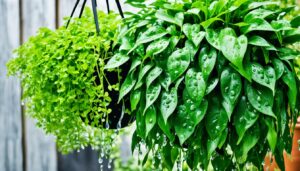Are you tired of unwanted guests nibbling on your beloved indoor plants? What if you could create a natural fortress around your green oasis to keep pests at bay, without resorting to harsh chemicals? In this comprehensive guide, we will explore natural solutions for keeping your houseplants bug-free. Say goodbye to harmful pesticides and hello to eco-friendly and effective pest control methods. From preventative measures to natural repellents and cultural controls, we’ve got you covered. Discover how to maintain a thriving and bug-free indoor garden using safe and natural solutions.
Key Takeaways:
- Natural pest control provides a safe and eco-friendly alternative to harsh chemical pesticides.
- Understanding common indoor garden pests will help you implement targeted pest control strategies.
- Preventative measures such as selecting pest-resistant plants and practicing proper watering techniques are crucial for a bug-free indoor garden.
- Natural repellents like botanical oils and companion planting can effectively keep pests away from your houseplants.
- Cultural controls, such as maintaining proper plant hygiene and providing optimal lighting and ventilation, create an unfavorable environment for pests.
Introduction
Welcome to our comprehensive guide on natural pest control for houseplants in your indoor garden. In this section, we will discuss the importance of eco-friendly solutions for keeping your plants bug-free. Say goodbye to harmful chemical pesticides and explore the benefits of opting for natural alternatives. By understanding the risks associated with traditional pest control methods and embracing eco-friendly solutions, you can create a healthy and thriving indoor garden.
Know Your Enemy
Before you can effectively control and prevent pest infestations in your indoor garden, it’s essential to know your enemy. Understanding the specific characteristics and behaviors of common indoor garden pests will help you implement targeted pest control strategies. Let’s take a closer look at some of the most troublesome plant pests and how to identify them:
- Aphids: These small, soft-bodied insects can appear in various colors, including green, black, yellow, or brown. They often cluster on new growth and buds and can cause leaf curling and yellowing.
- Mealybugs: Mealybugs are white, cottony insects with a waxy coating. They can be found on leaves, stems, and the underside of plants. Expect to see a sticky residue or black sooty mold when mealybugs are present.
- Spider Mites: Spider mites are tiny pests that are difficult to see with the naked eye. They cause webbing on plants, yellow or bronzed leaves, and damage to the plant’s overall health.
- Fungus Gnats: These small flying insects are often found hovering around the soil surface. Their larva feeds on organic matter in the soil and can damage plant roots.
- Scale Insects: Scale insects are typically found on stems and leaves and appear as small, raised bumps. They can be brown, black, or white in color and often secrete a sticky substance.
- Whiteflies: These tiny, white, moth-like insects can be found flying around your plants when disturbed. They feed on plant sap and can cause leaf yellowing, wilting, and stunting.
By familiarizing yourself with these common indoor garden pests and their distinguishing features, you’ll be equipped to take the necessary steps to combat them effectively. Armed with this knowledge, you can implement targeted pest control measures to protect the health and vitality of your houseplants.
| Pest | Description | Identification |
|---|---|---|
| Aphids | Small, soft-bodied insects that cluster on new growth. They can cause leaf curling and yellowing. | Look for clusters of small insects on leaves and new growth. Check for yellowing or curling leaves. |
| Mealybugs | White, cottony insects with a waxy coating. They are often found on leaves, stems, and the underside of plants. | Look for white, fuzzy insects on the plant’s surface, along with a sticky residue or black sooty mold. |
| Spider Mites | Tiny pests that cause webbing on plants, yellow or bronzed leaves, and overall plant damage. | Examine plants closely for webbing and signs of discoloration or damage on the leaves. |
| Fungus Gnats | Small flying insects often found near the soil surface. Their larvae feed on organic matter in the soil, potentially damaging plant roots. | Observe for small, flying insects around the soil surface and check for larvae in the soil. Look for signs of wilting or stunted growth in plants. |
| Scale Insects | Small, raised bumps on stems and leaves that come in brown, black, or white. They often secrete a sticky substance. | Inspect plants for small bumps on stems and leaves. Look for a sticky residue on the plant’s surface. |
| Whiteflies | Tiny, white, moth-like insects that feed on plant sap. They can cause yellowing, wilting, and stunting of the plant. | Watch for small white insects flying around plants when disturbed. Look for signs of yellowing or wilting leaves. |
Preventative Measures
Prevention is key when it comes to maintaining a bug-free indoor garden. By implementing various preventative measures, you can significantly reduce the risk of pest infestations and create an environment that is less attractive to common indoor garden pests.
- Select pest-resistant plants: Choose houseplants that are known for their pest-resistant qualities. Look for plants that have natural defenses against pests, such as strong foliage, sticky trichomes, or strong scents that repel insects. Some examples of pest-resistant plants include spider plants, geraniums, and marigolds.
- Practice proper watering techniques: Overwatering can create a damp environment that attracts pests like fungus gnats and root aphids. To prevent this, ensure that your plants are watered properly. Allow the top inch of soil to dry out between waterings and avoid letting water accumulate in the saucers beneath your pots.
- Maintain plant cleanliness: Regularly clean your plants by gently wiping the leaves with a damp cloth to remove dust and debris. This can help prevent the buildup of pests like spider mites and mealybugs, which often hide on the undersides of leaves.
- Isolate new plants: Before introducing a new plant to your indoor garden, quarantine it for a few weeks to monitor for any signs of pests. This will help prevent the spread of infestations to your other plants.
- Ensure proper air circulation: Good air circulation is essential for maintaining a healthy indoor garden and discouraging pests. Place your plants in areas with adequate ventilation, and avoid overcrowding them. This can help prevent the buildup of humidity and reduce the risk of pest infestations.
Natural Repellents and Solutions
When it comes to natural pest control for houseplants, you have a variety of options at your disposal. In this section, we will explore the use of natural insect repellents for plants, including homemade pest sprays made from botanical oils. We will also discuss the concept of companion planting, which involves strategically placing pest-repellent plants alongside your houseplants. These natural solutions can help protect your indoor garden from pesky insects while avoiding the use of harmful chemicals.
Cultural Controls
Cultural controls are essential practices and techniques that create optimal conditions for your houseplants and deter pests. By implementing these cultural control methods, you can effectively minimize the risk of pest infestations in your indoor garden.
Plant Hygiene
Proper plant hygiene is crucial for preventing pest infestations. Regularly inspect your plants for signs of pests, such as webs, discoloration, or damage. Remove any damaged leaves or plant parts to eliminate potential hiding spots for pests. Additionally, keep your gardening tools clean and sanitized to avoid spreading pests among your plants.
Proper Lighting and Ventilation
Providing adequate lighting and ventilation is key to creating an unfavorable environment for pests. Many pests thrive in moist and poorly ventilated spaces, so optimize your indoor garden’s lighting and ventilation to discourage their presence. Place your plants in areas with appropriate light levels according to their specific requirements. Ensure that there is proper air circulation by using fans or opening windows to maintain optimal airflow.
Temperature Control
Maintaining proper temperature levels in your indoor garden can help deter pests. Different pests have specific temperature preferences, so it’s important to create an environment that is less favorable for them. Be mindful of temperature fluctuations and avoid extreme heat or cold, as they can stress your plants and make them more susceptible to pest attacks. Use thermostats or heaters to maintain consistent and optimal temperatures for your houseplants.
| Cultural Control Methods | Benefits |
|---|---|
| Plant Hygiene | – Prevents pest infestations – Removes potential hiding spots – Maintains plant health |
| Proper Lighting and Ventilation | – Discourages pests with unfavorable conditions – Improves overall plant health – Reduces humidity and moisture |
| Temperature Control | – Creates less favorable environment for pests – Minimizes pest activity and reproduction – Promotes plant resilience |
Mechanical Controls
Mechanical controls are a hands-on approach to pest control in your indoor garden. They involve physically removing pests or implementing physical barriers to prevent their access. By implementing these mechanical control methods, you can effectively eliminate and deter pests from your indoor garden.
“The best defense is a good offense.” – Anonymous
1. Manual Removal of Pests
One of the most effective mechanical control methods is manual removal of pests. This involves physically picking off the pests, such as aphids or mealybugs, from your plants. Use a pair of tweezers or gloves to carefully remove the pests one by one. Be sure to dispose of them properly to prevent re-infestation.
2. Traps
Traps can be a useful tool in capturing and controlling pests in your indoor garden. There are different types of traps available, such as sticky traps or pheromone traps, depending on the type of pest you’re dealing with. Place the traps near infested plants to attract and capture the pests.
3. Barriers
Physical barriers can be an effective way to prevent pests from accessing your plants. Use materials like copper tape or sticky barriers around the base of your plant pots to create a barrier that pests cannot cross. This can help protect your plants from crawling insects like ants or slugs.
4. Pruning Infected Plant Parts
When dealing with pest infestations, it’s important to prune infected plant parts to prevent further spread of pests. Cut off and dispose of any leaves, stems, or branches that are heavily infested. Be sure to carefully sanitize your pruning tools between cuts to avoid spreading any pests to other plants.
Organic Pesticides
While chemical pesticides are not recommended for indoor gardens, there are organic alternatives that can effectively control pests. In this section, we’ll focus on organic pesticides specifically designed for indoor plants. We’ll explore natural pesticide alternatives such as neem oil and insecticidal soaps, discussing their effectiveness and how to properly apply them. By opting for organic pesticides, you can protect your plants without compromising their health or the environment.
Recovery and Maintenance
Pest infestations can be frustrating, but with proper recovery and maintenance techniques, you can restore your indoor garden to a bug-free state. In this section, we’ll discuss strategies for recovering from pest infestations and maintaining a bug-free environment moving forward.
Recovering from Pest Infestations
If your indoor garden has been invaded by pests, it’s important to take immediate action to eliminate the infestation. Here are some steps you can take to recover from pest infestations:
- Identify the specific pests and their extent of damage.
- Remove heavily infested plants from your indoor garden to prevent the spread of pests.
- Use appropriate organic pest control methods to eliminate the pests.
- Monitor the remaining plants closely for any signs of re-infestation.
Maintaining a Bug-Free Environment
Once you’ve successfully eliminated the pests from your indoor garden, it’s crucial to maintain a bug-free environment to prevent future infestations. Here are some key practices for ongoing pest management:
- Regularly inspect your plants for any signs of pests, including webs, holes in leaves, or sticky residues.
- Keep your indoor garden clean and free from debris that can attract pests.
- Ensure proper watering practices to prevent conditions that favor pest infestations.
- Monitor the humidity and temperature levels in your indoor garden to create an unfavorable environment for pests.
By staying vigilant and proactive in your pest management efforts, you can ensure the long-term health and vitality of your indoor garden, keeping it bug-free and thriving.
Conclusion
By implementing the natural solutions for indoor garden pests discussed in this comprehensive guide, you can achieve a bug-free environment for your houseplants. The benefits of using eco-friendly pest control methods cannot be overstated. Not only do these natural solutions protect your plants from harmful pests, but they also minimize the use of chemicals that can be detrimental to the health of your plants and the environment.
Throughout the article, we’ve emphasized the importance of preventative measures, such as selecting pest-resistant plants and practicing proper watering techniques. We’ve also explored the effectiveness of natural repellents and solutions, including homemade pest sprays made from botanical oils and the concept of companion planting. Additionally, we’ve delved into cultural and mechanical controls, which focus on creating optimal growing conditions and physically removing pests from your indoor garden.
Moving forward, it is essential to regularly inspect and monitor your houseplants to prevent and address any potential pest infestations. By staying vigilant and proactive, you can maintain a bug-free indoor garden. Remember, the joy of nurturing a thriving and pest-free indoor garden is within your reach, thanks to the use of natural solutions and eco-friendly pest control methods.
For more valuable Expert Tips check out our comprehensive Houseplant Guide to Tips for Indoor Plant Care.
If you happen to be nearby, stop in at The Landscape Connection and say Hi. Michelle and I would love to meet you.
FAQ
Why is natural pest control important for houseplants in my indoor garden?
Natural pest control is important because it avoids the use of harmful pesticides and promotes eco-friendly solutions. It helps maintain a bug-free environment while ensuring the health and vitality of your indoor plants.
Which pests are common in indoor gardens?
Common pests in indoor gardens include aphids, mealybugs, spider mites, and fungus gnats. Each pest has specific characteristics and behaviors that can be identified to implement targeted pest control strategies.
What are some preventative measures for keeping pests away from houseplants?
Preventative measures include selecting pest-resistant plants, practicing proper watering techniques, and maintaining plant hygiene. These proactive strategies can significantly reduce the risk of pest infestations in your indoor garden.
What are some natural repellents and solutions for houseplant pests?
Natural repellents include homemade pest sprays made from botanical oils. Companion planting is another effective method, where pest-repellent plants are strategically placed alongside houseplants to deter insects. These natural solutions can help protect your indoor garden from pesky pests.
What are cultural controls and how can they help with pest control for houseplants?
Cultural controls are practices that create optimal growing conditions while deterring pests. These include maintaining proper plant hygiene, providing adequate lighting, ventilation, and temperature control. By implementing these techniques, you can minimize the risk of pest infestations.
What are some mechanical control methods for indoor garden pests?
Mechanical controls involve physically removing pests or implementing physical barriers. Methods include manual removal of pests, using traps and barriers, and pruning infected plant parts to prevent further pest spread.
Are there organic pesticides for indoor plants?
Yes, there are organic alternatives such as neem oil and insecticidal soaps that can effectively control pests in indoor gardens. These organic pesticides are safer for both your plants and the environment.
How do I recover from a pest infestation in my indoor garden?
Recovery involves regular inspection and monitoring, as well as ongoing pest management practices. By staying vigilant and proactive, you can eliminate pests and maintain a bug-free environment in your indoor garden.
What are the benefits of using natural solutions for indoor garden pest control?
Using natural solutions for pest control minimizes the use of harmful chemicals and protects the health of your plants. It is also eco-friendly and promotes a safe and sustainable gardening environment.




